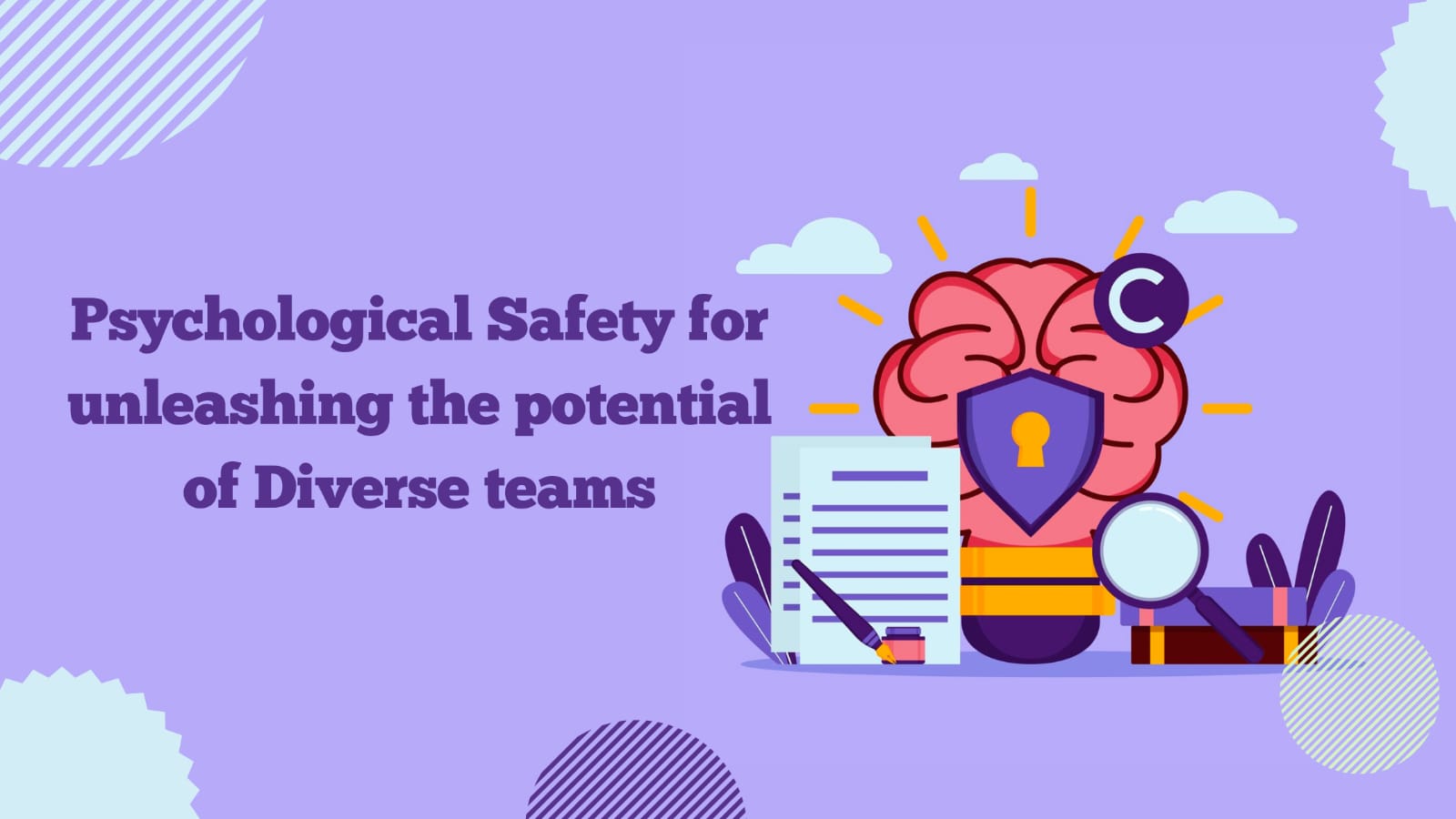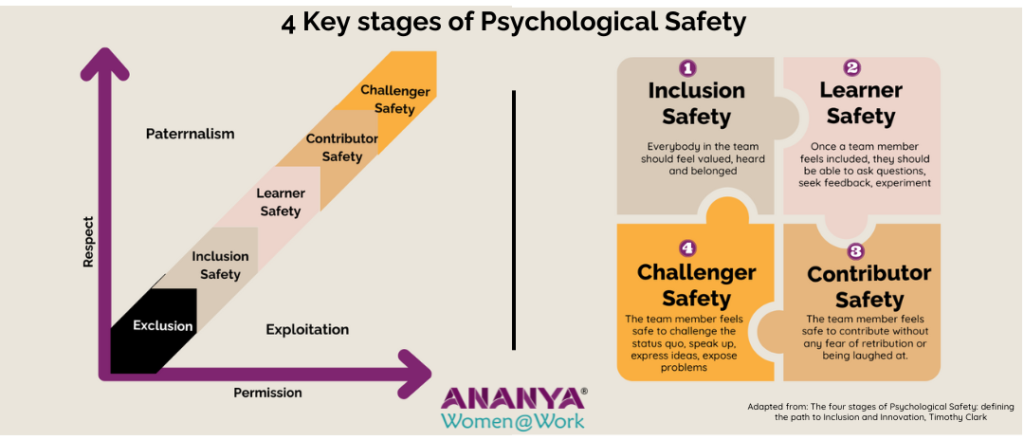
What is psychological Safety
Psychological Safety was a term popularised by Amy Edmondson. While doing her research about effective teams she chanced upon the statement “Effective teams make more mistakes”, which was contrary to what her research hypothesis “Effective teams make fewer mistakes”. Upon further research, she found that “Effective teams report more mistakes”. The members of the team are comfortable sharing their mistakes, they are willing to learn from mistakes and not afraid to be their authentic selves.
Psychological Safety and Diverse Teams
We know empirically and intuitively that diverse teams are more innovative, creative and highly productive. However, harnessing the power of diversity is more than bringing people from diverse backgrounds and perspectives together. It is upon the leaders to be intentional in their attempt to bring out the best in the team.
To foster a culture of psychological safety it is upon the leader to create an environment where team members feel safe to take risks, report mistakes, express themselves authentically, and contribute their unique insights without fear of judgment or reprisal. This is especially true for teams where the members belong to different identities especially the ones belonging to the under-represented group(s).
Benefits of Psychological Safety in the team
By encouraging open communication and collaboration, team members are in a position to share diverse viewpoints and/or challenge conventional thinking. This fosters creativity and problem-solving, leading to more innovative solutions and better outcomes. Such environment also promotes trust and mutual respect among team members, which enhances morale, engagement, and retention.
In a nutshell, the members of the team
- Feel they belong: there is a heightened sense of camaraderie and being include
- Open to being challenged
- Are comfortable to contribute new ideas without the fear of being ridiculed, demeaned or laughed at
- Willing to respectfully challenge ideas presented by others
- Share concerns and mistakes without fear of retribution
Psychological Safety – What it is not
- Lack of Accountability: Psychological Safety does not mean that non-performers can hide behind excuses. Leaders must discern between excuses and mistakes.
- False Harmony: Have you ever experienced a person who is warm but still not comfortable to be around? Niceness is not psychological Safety; It may be an indicator of brewing conflict. Shying away from intellectual debate under the guise of being nice in a way paralysis the team’s performance over a period of time.
- Consensus decision-making: Waiting for everyone’s agreement may delay the process of decision-making. Psychological safety will help the members present their dissent, their concerns and their perspectives. The leader continues to hold the authority to take decisions and the group gives their commitment to the decision.
- Replacement of policies, procedures and structures: The organisation’s policies and procedures supersede any other rule that the team may develop for themselves. The reporting structure, the decision-making authority, the approval process(es), the work allocation, etc all remain.
- Political Correctness: Being politically right or pursuing a political agenda is not what psychological safety is about. It does, however, talk about being respectful and communicating your point of view even if it is contrarian.
- Static Concept: Psychological safety is an ongoing process. It cannot be achieved. Leaders and team members have to be intentional and continuously follow the principles to foster an environment where everyone feels valued.
- Lip Service: Talking about it does not amount to psychological safety. It is manifest in everyday behaviours and how every member is treated.

The 4 Key Stages of Psychological Safety
As indicated in the diagram above the four key stages are
- Inclusion Safety
- Learner safety
- Contributor Safety
- Challenger Safety
When a leader can foster an environment of Challenger Safety, innovation happens. The leader plays a crucial to move the members of the team from the feeling of Inclusion Safety to the feeling of Challenger Safety
Leader’s role in creating Psychological Safety
As Edmondson puts it, “it’s felt permission for candour.” Leaders have a primary role to play in building psychological safety. With their compassionate approach, they initiate in establishing clear norms and expectations, encouraging open communications and new ideas, actively listening, showing appreciation where it is due.
- Make clear why employees’ voices matter: Be explicit about why their opinions matter and how it could impact the outcome. Someone I know usually never contributed in meetings assuming she was young and new, but when she spoke up, her leader appreciated the new perspective and emphasised how much the team misses out when she keeps quiet.
- Admit your own fallibility: Vulnerability is gaining recognition as one of the key ingredients of an authentic leader. When a leader shares their learnings from their past mistakes and openness to receiving feedback from the team, they are setting a tone for everyone.
- Be aware of your own biases: By knowing and acknowledging their own biases, leaders pave the way for every team member to be open to feedback & reflect their own biases
- Actively invite inputs: A common mistake is to ask “Do you have anything to add?”. Instead ask, “What is your opinion about it?” and ensure everyone adds. This does not come easy to many, as they have been trained not to speak up. consistent efforts will yield results/
- Respond productively: Chuck the common phrases “We’ve tried this before”, “It will not work here” etc and replace them with “Tell me more” to be curious. Harbouring a growth mindset, approaching every idea with genuine curiosity and actively listening are some of the ways to promote psychological safety.
In Conclusion
Psychological safety is not just a buzzword which will fade away with time as does fashion. For organisations to thrive, they will have to be intentional in building a culture of psychological safety. By prioritizing inclusivity, empathy, and mutual respect, leaders can create environments where diverse teams thrive, innovate, and succeed together.
For leaders, it is an ongoing commitment to foster an environment where everyone feels safe and included. Team success lies not only in embracing differences but in creating a space where every individual feels valued and respected, every voice is encouraged and heard, risk-taking is celebrated, constructive feedback is welcomed and there is a strong sense of belonging that every member of the team experiences.
References
- “Fearless Organisation” , Amy Edmondson
- HBR Article by Amy Gallo “What is psychological safety”
- Forbes article by Timothy Clark “What psychological safety is not”
If you want to build a culture of psychological safety, please write to us at connect@ananyawomenatwork.com
